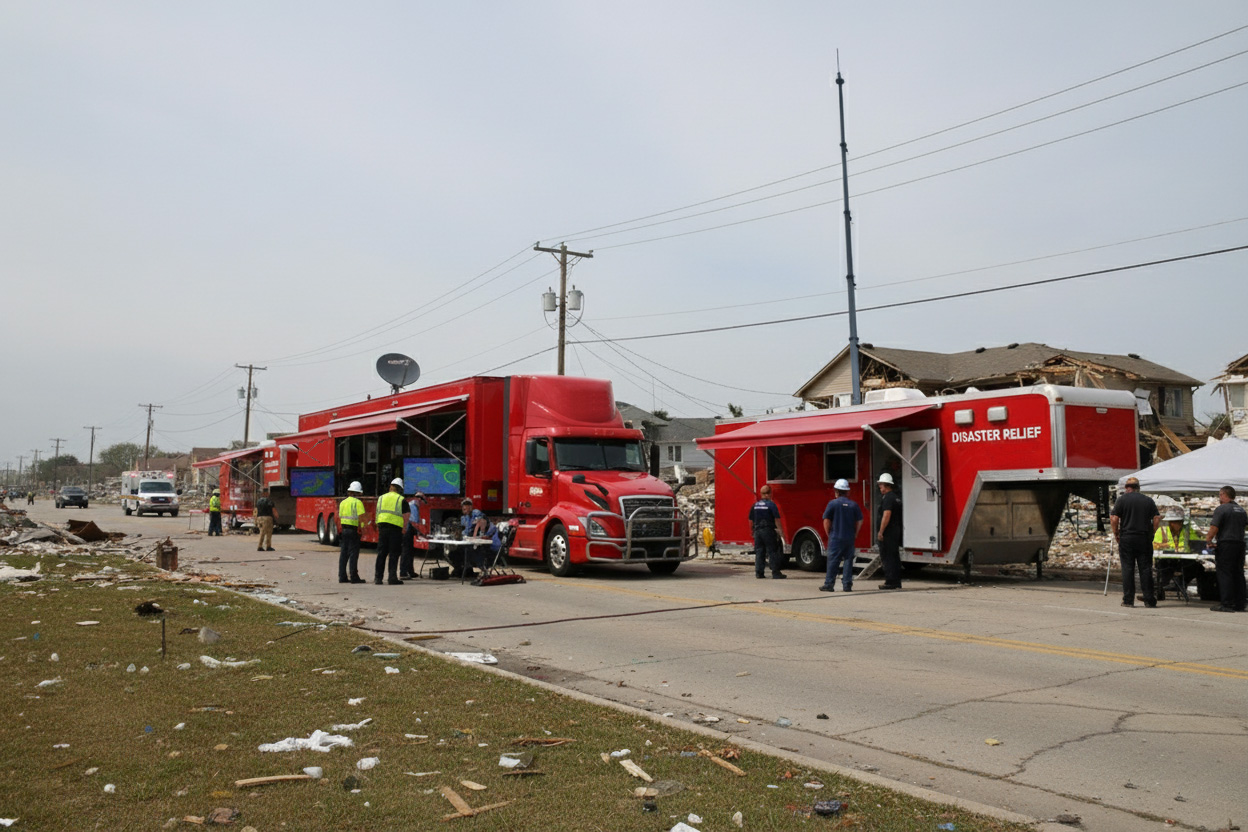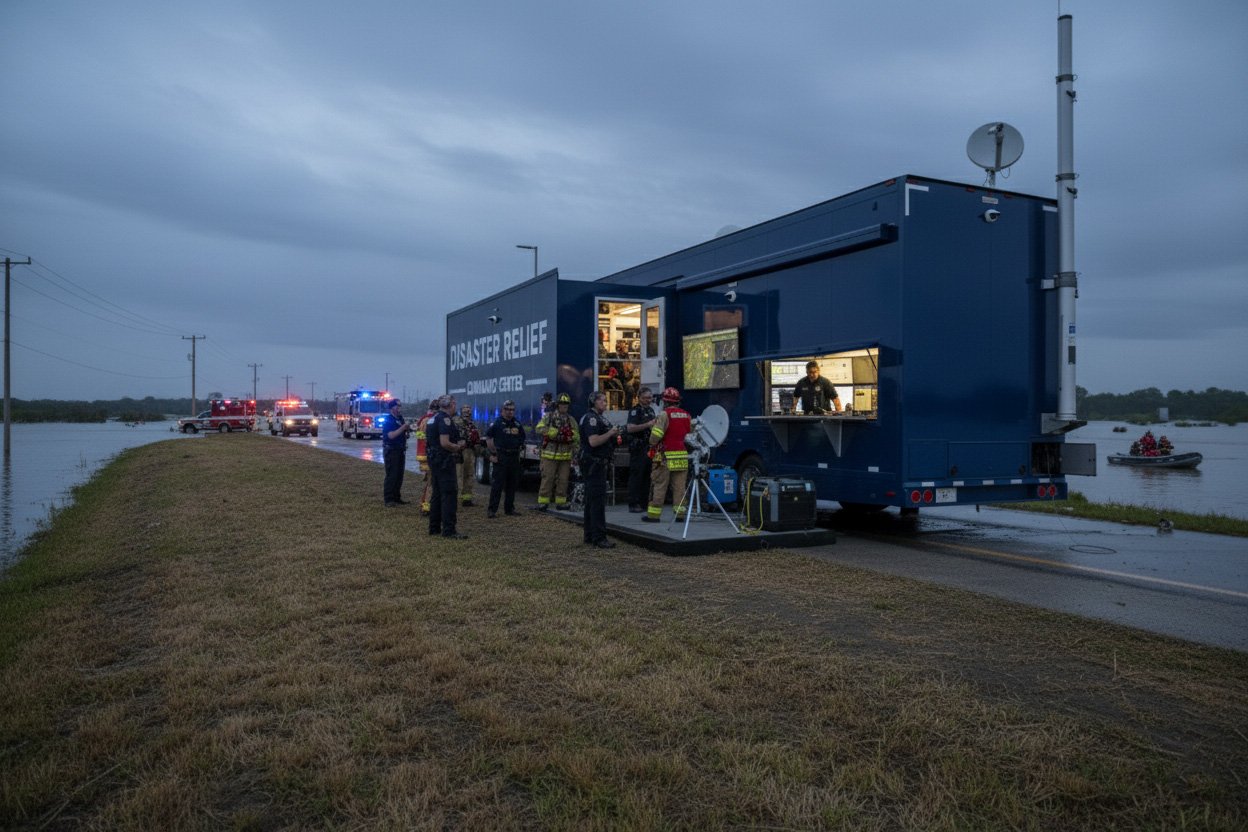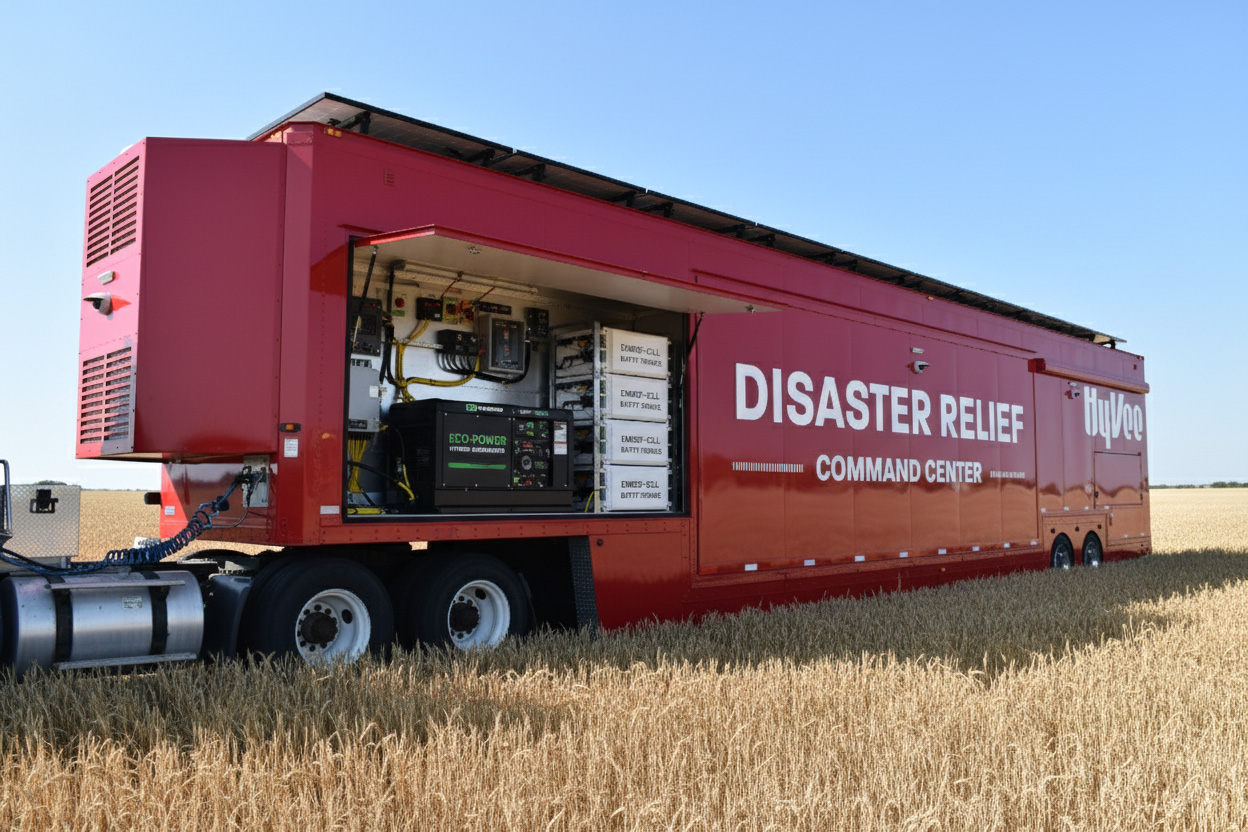How Mobile Command Centers Improve Coordination During Natural Disasters
When natural disasters strike, chaos and disruption follow. Traditional communication networks collapse, mobility becomes restricted, and...
9 min read
Craftsmen Industries Nov 20, 2025 4:04:01 AM

In today’s rapidly evolving threat environment, where natural disasters strike, urban incidents escalate, and critical infrastructure faces growing pressure, the ability of response teams to deploy command infrastructure instantly and maintain seamless communication can make all the difference. A mobile command center brings the operational hub directly to the scene, combining real‑time coordination, data integration, surveillance, and multi‑agency collaboration in a field‑ready platform.
The urgency for such mobile capability is reflected in market dynamics: the global mobile command center market was valued at approximately USD 2.14 billion in 2024, and it is forecast to grow to around USD 5.5 billion by 2035 at a compound annual growth rate (CAGR) of roughly 8.9%. This robust growth highlights how governments and organisations are increasingly investing in mobile assets to support emergency operations, disaster response, and mission‑critical coordination.
In this article, we explore why mobile command centers are essential for emergency operations. We will delve into their role in disaster response, the core features that define their operational effectiveness, design and engineering considerations explicitly tailored for emergency use, the deep technology integration that powers them, and future‑facing trends that will shape how these units evolve.

Mobile Command Centers (MCCs) are specialized vehicles designed to serve as self-contained operational hubs during emergencies. Unlike traditional stationary command posts, MCCs bring critical communication, coordination, and decision-making capabilities directly to the field, enabling response teams to operate effectively in dynamic, often unpredictable environments.
Another essential aspect of MCCs is their ability to provide a centralized operational environment. Inside the vehicle, teams have access to briefing areas, monitoring consoles, workstations, and even rest spaces for prolonged deployments. This interior planning enables agencies to operate efficiently under high-pressure conditions, streamlining communication and decision-making. Ergonomic and modular designs ensure the space can be adapted for a range of missions, from disaster management to large-scale public safety operations.
Mobile Command Centers transform emergency response by bringing the command post directly to the field. Their mobility, technological sophistication, and operational flexibility make them indispensable for modern emergency operations. By reducing response times, improving situational awareness, and supporting multi-agency collaboration, MCCs play a pivotal role in enhancing the efficiency and effectiveness of emergency management worldwide.
Mobile Command Centers (MCCs) are engineered to provide field-ready capabilities that integrate technology, mobility, and operational efficiency. In emergency operations, these centers serve as critical hubs for communication, coordination, and decision-making. Below are the core features that make MCCs indispensable in modern emergency management.
Reliable communication is the backbone of any emergency or disaster response. MCCs integrate satellite uplinks, LTE/5G connectivity, and interoperable radio systems, ensuring continuous communication between field units, central command, and multiple agencies. Mesh networks are often used to maintain connectivity in areas where conventional infrastructure has failed. Deployments with robust communication systems have been shown to significantly improve coordination and reduce response delays.
MCCs are equipped with real-time surveillance systems, including PTZ cameras, drones, and video walls. These tools allow operators to monitor affected areas, identify hazards, and make data-driven decisions. AI-assisted analytics further enhance situational awareness by detecting anomalies or threats faster than human monitoring alone. For instance, MCCs deployed during wildfire operations have significantly improved response planning and coordination.
Emergencies often occur in regions where power infrastructure is compromised. MCCs incorporate generators, solar panels, and hybrid power systems, allowing uninterrupted operations. Redundant energy solutions keep communication, surveillance, and IT systems functional for extended periods, with some units capable of operating independently for up to 72 hours.
The interior of an MCC is carefully designed for multi-agency operations, featuring workstations, briefing areas, and communication consoles. Modular layouts allow reconfiguration depending on the mission, while ergonomic design ensures comfort during prolonged deployments. Some units also include medical support spaces and rest areas to sustain personnel during extended operations.
MCC platforms range from vans and trucks to semi-trailers, ensuring rapid deployment even in challenging terrain. Weight distribution, suspension, and off-road capabilities are optimized to allow field operations to begin immediately. This mobility drastically reduces response times, which is critical in life-saving scenarios.
Modern MCCs centralize data from multiple sources, including field sensors, surveillance systems, weather monitoring, and emergency databases. Integrated dashboards allow decision-makers to prioritize resources, plan evacuations, and respond dynamically to changing conditions. Agencies using these systems reported improved decision-making speed by up to 25% during large-scale emergencies.
These core features make MCCs vital tools for modern emergency operations, enabling rapid deployment, robust communication, and real-time situational awareness in environments where traditional infrastructure may fail.

When designing a mobile command center (MCC) for emergency operations, the engineering process must translate mission requirements into a ready‑to‑deploy vehicle. This means carefully assessing needs, choosing the right platform, designing the interior for multi‑agency use, and building in redundancy for communications and power. The following considerations outline how to ensure an MCC is fit for emergency deployment.
The first step is a rigorous needs assessment: defining the operational scope, the agencies involved, the likely environments (urban, remote, disaster‑affected), and the expected mission durations. During the assessment phase, one must establish the number of workstations required, the communication bandwidth, connectivity requirements (satellite, LTE/5G, radio), mobility parameters (road, off‑road), and deployment speed goals (for example, operational within 30 minutes of arrival).
A well‑structured assessment aligns client, architects, engineers, and end‑users, ensuring that design decisions are mission‑driven rather than purely aesthetic.
Once the platform is chosen, interior ergonomics design becomes critical. Emergency operations often involve multi‑agency teams (fire, police, EMS, utility) working side‑by‑side. Modular interiors, such as slide‑out compartments or interchangeable racks, enable a single MCC to serve multiple scenarios. As one industry provider notes, modular and expandable designs “enhance operational efficiency and future‑proof mobile command centers”.
Materials must be durable, easy to maintain, and optimized for both movement (on‑road/off‑road) and station operations. Interior layouts should segregate high‑traffic zones (briefing room) from quiet zones (data racks) to optimize workflow and minimize cross‑interference.
Selecting the right vehicle platform is a foundational engineering decision. Vehicle types include vans (urban rapid response), truck platforms (larger payloads, off‑road), trailers or semi‑trailers (extended mission capability), and specialty chassis (armoured, all‑terrain).
According to market data, “trucks currently account for approximately 41% of total revenue in the vehicle‑type segment of mobile command vehicles in 2024”. This reflects their suitability for heavier payloads and rugged environments. Specifications like GVWR, axle load, suspension, weight distribution, approach/departure angles, and deployment stability must all be engineered. The vehicle must also support slide‑outs or expansions without compromising structural integrity or mobility.
Failure is not an option in emergency operations. Redundancy in both communications and power systems ensures continuity of operations even in degraded environments. For example, a manufacturer notes dual power systems (generator + battery backup) and solar compatibility as standard features for mobile command centers. Communication redundancy may include satellite linking, LTE/5G, radio mesh networks, and wired options where available.
Redundant paths must automatically fail over without operator intervention. Power systems should support mission‑critical loads, communications, surveillance, HVAC, and lighting for extended off-grid durations (24‑72 hours or more). Engineers must calculate load demand, generator sizing, battery capacity, fuel consumption, and thermal management to guarantee performance in austere conditions.

As disaster response and field operations become increasingly data-driven, sustainability and innovation are shaping the next generation of emergency Mobile Command Centers (MCCs). These vehicles are now being designed with energy efficiency, digital intelligence, and automation in mind, offering a more resilient and environmentally responsible foundation for critical response efforts.
Manufacturers are transitioning toward lightweight aluminum composites and recycled polymers to minimize fuel consumption and enhance mobility across rugged terrain. Additionally, green coatings and low-emission interior finishes are being adopted to reduce volatile organic compound (VOC) emissions, improving crew safety and environmental sustainability.
Energy independence is becoming a hallmark of modern MCCs. Solar arrays and hybrid generators now provide silent, emission-free power during prolonged field operations. According to Fortune Business Insights, the global hybrid power solutions market was valued at USD 2.23 billion in 2024 and is projected to reach USD 4.24 billion by 2032, expanding at a CAGR of 8.33%, growth largely driven by defense, telecom, and emergency deployment sectors.
These renewable energy integrations not only reduce operational costs but also ensure uninterrupted operation during grid outages or fuel shortages, which are vital in disaster-prone regions.
The use of digital twin technology, virtual replicas of physical MCCs, has become a breakthrough for predictive maintenance and real-time scenario planning. Digital twins enable engineers and emergency planners to test multiple disaster conditions before deployment, optimizing readiness. By simulating communication breakdowns, power failures, or terrain limitations virtually, agencies can enhance the reliability and agility of their MCC fleets.
The future of MCCs lies in autonomous, remotely operated platforms designed for deployment in high-risk environments such as wildfires, chemical spills, or active combat zones. These AI-assisted vehicles can navigate independently, maintaining command and surveillance capabilities even when human operators must stay at a safe distance.
When disasters strike, seconds count, and the ability to make fast, informed decisions can determine the difference between containment and chaos. Mobile Command Centers (MCCs) have revolutionized emergency operations by providing fully equipped, mobile headquarters that connect multiple agencies, manage real-time intelligence, and deploy resources efficiently in the field.
One of the primary advantages of MCCs is the dramatic reduction in emergency response times. By bringing command-and-control functions directly to the crisis site, MCCs allow responders to bypass the delays associated with remote coordination centers.
Implementing smart and connected technologies, including mobile command systems, can reduce emergency response times by 20% to 35% by improving situational awareness and enabling faster communication between field teams. For instance, during the California wildfires, MCC-equipped teams established communications and incident control within hours, far faster than traditional, stationary setups.
MCCs serve as data-driven hubs that synthesize live video feeds, satellite imagery, and GIS data to improve situational awareness. Integrated dashboards display a live operational picture, allowing command teams to assess resource needs and make quick, informed decisions.
The U.S. Department of Homeland Security (DHS) reports that real-time data integration can improve the accuracy of field decision-making by over 40%, particularly in dynamic disaster environments. Whether managing flood zones, coordinating evacuations, or tracking rescue teams, this situational intelligence drastically enhances operational precision.
Emergency scenarios often involve multiple departments, fire, police, medical, and utility teams, each operating on separate systems. MCCs bridge these communication silos through interoperable networks that unify radio, cellular, and satellite communications. The National Emergency Communications Plan (NECP) emphasizes that interoperable communication infrastructure improves inter-agency collaboration.
This shared platform allows diverse teams to coordinate seamlessly, share intelligence, and allocate resources effectively without communication breakdowns.
Unlike permanent command centers that require years of investment and location-specific facilities, MCCs offer mobility, scalability, and long-term value. They can be redeployed across multiple disaster zones or repurposed for training, surveillance, and public safety missions. Additionally, MCCs are easier to upgrade as new communication and sensor technologies evolve, ensuring agencies remain adaptable in a fast-changing world.
Mobile units empower first responders, law enforcement, and emergency management teams to establish immediate command capabilities wherever disaster strikes. By integrating advanced communication, surveillance, and power systems, MCCs ensure uninterrupted operations even in areas where infrastructure has failed. Their ability to enhance situational awareness, accelerate decision-making, and unite multi-agency efforts has positioned them as the modern backbone of field-level emergency response.
For organizations seeking a partner to design, engineer, or fabricate mission-ready MCCs, Craftsmen Industries stands out as a leader in innovation and reliability. With decades of experience in building specialized vehicles for defense, emergency, and broadcast applications, Craftsmen Industries combines cutting-edge technology with durable craftsmanship to deliver mobile command centers that perform under pressure.
By collaborating with Craftsmen Industries, agencies and municipalities can ensure their teams are equipped with the most advanced and sustainable MCCs available today.
A Mobile Command Center (MCC) is a specially engineered vehicle that serves as a mobile operations hub during emergencies. It enables incident commanders to coordinate rescue, communication, and logistics directly from the field. By providing on-site command, MCCs eliminate reliance on remote facilities, ensuring faster, more effective response and control during disasters or large-scale events.
Emergency MCCs are used by law enforcement agencies, fire departments, emergency medical services (EMS), military units, and disaster management authorities. Utility companies and public health organizations also deploy them for crisis response, field assessments, and large community events requiring communication and control infrastructure.
Effective MCCs integrate redundant power systems, multi-channel communications, satellite and LTE connectivity, GIS mapping, and real-time video surveillance. They’re also equipped with conference areas, data consoles, and dispatch tools, allowing multi-agency coordination and decision-making in real time, even in communication-deprived environments.
Deployment times vary by vehicle type and mission profile, but most MCCs can be operational within 1 to 3 hours after arrival on-site. Their preconfigured communication systems, self-contained power, and modular setups minimize setup time, allowing immediate coordination of response efforts.
Modern MCCs employ a mix of AI-powered video analytics, drones, GPS tracking, and data visualization dashboards to deliver real-time situational awareness. These systems aggregate live feeds from field sensors, cameras, and responders, giving commanders a dynamic, accurate operational picture to guide critical decisions.
MCCs undergo scheduled maintenance cycles similar to heavy-duty vehicles, combined with regular system diagnostics for communication and IT components. Software updates, sensor calibration, and cybersecurity checks are part of continuous readiness programs; MCCs remain mission-capable year-round.
Yes. MCCs are significantly more cost-efficient because they can serve multiple missions and locations with one investment. Unlike fixed command centers, which require construction and maintenance costs, MCCs offer flexibility and reusability, reducing long-term operational expenses.

When natural disasters strike, chaos and disruption follow. Traditional communication networks collapse, mobility becomes restricted, and...

In an era where rapid-response capabilities are increasingly vital, the investment in a mobile command center (MCC) has become more than just a...

Wildfires are among the most devastating natural disasters, causing widespread destruction and loss of life. Effective management of these fires...